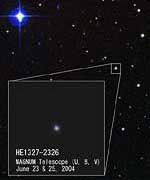
Image credit: ANU
Listen to the interview: Oldest Star Discovered (2.5 mb)
Or subscribe to the Podcast: universetoday.com/audio.xml
Fraser Cain: How old is this star that you’ve found?
Anna Frebel: Well, that’s a bit of a problem because we cannot actually place an exact age on the star. You would need to measure radioactive elements in the star and if you said already that the star if very primitive, it is mint condition, so we don’t see any radioactive elements and hence we can only make a good guess on how old it is.
Fraser: How does it look different from our own sun?
Frebel: It’s very different from our Sun. We found the star because it had very low iron as compared to the Sun and this is also the reason why we think it is the oldest star because it has the lowest iron ever observed, and not only the iron, but also many other elements; carbon and nitrogen are very low as compared to the Sun.
Fraser: Why does our Sun have larger amounts of iron and this one doesn’t?
Frebel: If you consider the chemical evolution of the galaxy, and the entire universe, and you might know that after the Big Bang, the universe started out only with hydrogen and helium, and a little bit of lithium, and all the time, the heavy elements were synthesized in the stars themselves, now, certain elements such as carbon, nitrogen, oxygen and iron were synthesized during the lifetime of stars, but other elements, especially the heavy ones, were produced in supernova explosions; the death of a big star. So over time, the stars got enriched more and more in heavy elements; the Sun is not very old by astronomical standards, hence it has much more heavy elements than the star 183027, which was what we found.
Fraser: So you are saying that normal stars like our Sun have been through the wash cycle several times, and they have had their matter recycled through several stars, and that’s why they have some of the higher elements in them. How can a star remain untouched from such a long period?
Frebel: Well the density of stars in some areas is rather low and others, it’s higher; this star is a field halo star, so it’s in an area of our galaxy which is not very populated, so it’s just been sitting there for many, many, many years, and because it’s a low mass star, it is still very unevolved, so it’s just waiting there for us to find it.
Fraser: What kind of star is it, because I understand that our Sun is several billion years old, but definitely not the age of the universe, so what kind of star is it that it could be as old as the Big Bang?
Frebel: The star is a low mass star, it’s a bit lighter than the Sun and that means that it evolved very very slowly. I mean the Sun, well, it’s still in its teenage years, so it hasn’t burned much. High mass stars burn very very fast, and they explode quickly as a supernova enriching the surrounding gas; the interstellar medium with heavy elements, but this star, because it is so low in mass has just been sitting there and burning its hydrogen slowly and we think the hydrogen has just finished burning. So helium should be the next stage.
Fraser: How early on do you think it actually formed? How long after the Big Bang?
Frebel: Well, we have 2 scenarios; one would be that it formed in the second generation of stars and the first generation formed within one billion years after the Big Bang. So that star should have formed very quickly, probably about one billion years after the Big Bang. And the second theory which we cannot exclude, although I personally don’t favor it, is that the star indeed is a first star itself, meaning that it formed as one of the very, very first stars in the universe and presumably that happened then within the first billion years.
Fraser: Do you think that there are many of these types of stars in the Milky Way?
Frebel: Good question; probably not because they are very old and hence they are very rare because it seems that there is a certain type of these low mass stars which are actually able to survive that long and astronomers have been searching for these types of stars for the last 30-40 years and so far, we’ve only found 2 in huge efforts, so we are really looking for the needle in the haystack I would say.
Fraser: In the last couple of years, I have been covering the fires at Mount Stromlo. How is the observatory doing?
Frebel: It’s doing very well. We haven’t been affected from a science point of view. We have been very much productive since the fires. The reconstruction has now started; we are getting an new advanced, technological instrumentation building so we have a lot of noise here, but that also means things are progressing. Everyone is doing very well and we’ve, I think psychologically, we’ve put the fires way behind us.

What is the name of the oldest star.Give the full details & the structure with it’s age & the name of the astronomer that discovered the star & how was the star formed